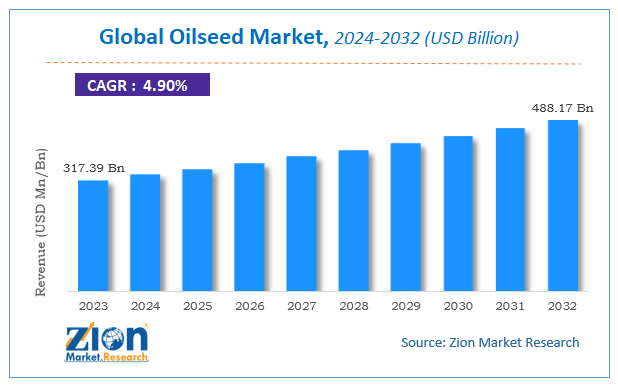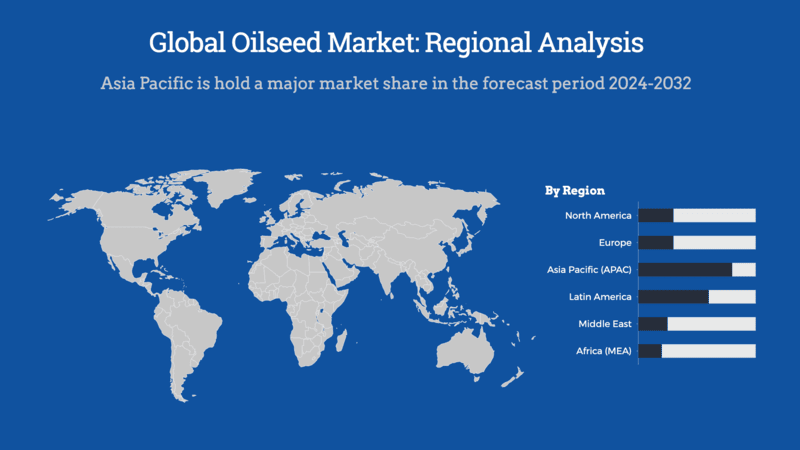Oilseed Market Size, Share, Demand, Future Growth Analysis, Industry Forecast 2032

Oilseed Market - By Category (Genetically Modified and Conventional), By Type (Sunflower, Soybean, Palm Kernel, Cottonseed, Rapeseed, Groundnut, Copra, and Others), By Application (Oilseed Meal and Vegetable Oil), And By Region - Global Industry Perspective, Comprehensive Analysis, and Forecast, 2024 - 2032
| Market Size in 2023 | Market Forecast in 2032 | CAGR (in %) | Base Year |
|---|---|---|---|
| USD 317.39 Billion | USD 488.17 Billion | 4.9% | 2023 |
Global Oilseed Market Insights
Zion Market Research has published a report on the global Oilseed Market, estimating its value at USD 317.39 Billion in 2023, with projections indicating that it will reach USD 488.17 Billion by 2032. The market is expected to expand at a compound annual growth rate (CAGR) of 4.9% over the forecast period 2024-2032. The report explores the factors fueling market growth, the hitches that could hamper this expansion, and the opportunities that may arise in the Oilseed industry. Additionally, it offers a detailed analysis of how these elements will affect market demand dynamics and market performance throughout the forecast period.
Global Oilseed Market Overview
Oilseeds have myriad applications due to its huge protein content. In addition to this, the product imparts key functional features like water & oil holding capacity, viscosity, emulsification, and whipping capacity when added to other foods. For instance, soybean & rapeseed protein isolates possesses huge whipping capacity. Furthermore, oilseeds find extensive application in pharmaceutical, food, animal feed, and cosmetics industries. Apparently, oil derived from oilseeds is utilized in food items for human intake and residue of the same oil is utilized in animal feed.
Furthermore, oilseeds are utilized in printer inks, paint binders, and varnishes. These products are also used in producing cooking oil and cosmetics.
Key Insights
- As per the analysis shared by our research analyst, the global Oilseed Market is estimated to grow annually at a CAGR of around 4.9% over the forecast period (2024-2032).
- In terms of revenue, the global Oilseed Market size was valued at around USD 317.39 billion in 2023 and is projected to reach USD 488.17 billion by 2032.
- Based on the product type, Soybeans are the largest segment in the oilseed market, widely used for oil extraction and as a source of protein in animal feed.
- Based on the Category, Conventional oilseeds currently hold the most significant market share. However, the genetically modified segment is expected to grow at the fastest rate during the forecast period, driven by increased productivity and resilience to environmental stresses.
- Based on the Application, The vegetable oils segment is the largest application segment, driven by strong demand from the food industry for products like bakery and confectionery items, sauces, spreads, dressings, meat products, and ready-to-eat snacks.
- Based on the Region, Asia-Pacific is the largest regional market for oilseeds, contributing more than 35.12% of the revenue share in 2024.
Oilseed Market Growth Dynamics
Key Growth Drivers
Massive demand for plant oil across the bio-diesel sector will propel the expansion of oilseed industry over the forecast timespan. In addition to this, large-scale use of oilseeds in bio-fuels, households, and food service sectors is likely to create lucrative growth avenues for the market in the foreseeable future. Apparently, rise in the adoption of vegetable oil along with enhanced cultivation of oilseeds across the globe will further prompt the elevation of the market size over the years to come.
Restraints
Humungous use of soybean due to its high protein content will spur the industry landscape in the years ahead. Nonetheless, oscillating costs of the oilseeds are likely to put brakes on the market earnings in the years to come. Apart from this, swift changes in the climatic conditions can adversely impact the crop yield, thereby further obstructing the industry progression. However, with new entrants entering the business, the oilseed market growth graph is predicted to experience an immense upsurge over the coming decade, thereby nullifying the negative impact of hindrances on the market growth. Many of the oilseeds like sesame oil and rapeseed oils are used as marinades in European countries, thereby steering the business space.
Opportunities
The oilseed market is primarily driven by the growing global demand for vegetable oils and protein meals, fueled by the expanding food and beverage industry. Increasing health consciousness among consumers has led to a preference for plant-based oils, particularly for cooking and food processing. Additionally, the rising popularity of biodiesel as a renewable energy source has significantly boosted the demand for oilseeds like soybean, sunflower, and rapeseed. Technological advancements in seed breeding, genetic engineering, and agricultural practices have improved crop yields, further supporting market growth. Government initiatives promoting oilseed cultivation and offering subsidies to farmers also act as key growth drivers.
The oilseed market faces challenges from fluctuating raw material prices caused by unpredictable weather patterns, pests, and diseases, which can impact crop yields and supply chains. Additionally, the reliance on chemical fertilizers and pesticides raises environmental and sustainability concerns, leading to stricter regulations on agricultural practices. Trade restrictions, tariffs, and geopolitical uncertainties can further hinder market growth by affecting the global supply and pricing of oilseeds. Furthermore, competition from alternative sources of oils, such as palm oil, limits the growth potential of other oilseeds.
Challenges
The increasing adoption of sustainable and organic farming practices presents significant opportunities in the oilseed market. Consumers are showing a growing preference for non-GMO and organic products, encouraging farmers and producers to expand their organic oilseed production. Additionally, the rise of plant-based diets and the growing demand for plant protein in food products create new opportunities for oilseed-derived protein meals and isolates. Developing regions, particularly in Asia-Pacific and Africa, offer untapped potential for market growth due to rising disposable incomes and evolving dietary patterns. Innovations in biotechnology and precision farming also enable higher productivity and better quality oilseeds, opening new avenues for market players.
The oilseed market faces challenges related to climate change and unpredictable weather conditions, which can adversely affect crop yields and quality. Water scarcity, soil degradation, and declining arable land further limit the expansion of oilseed cultivation. Additionally, the market is highly competitive, with major players dominating through extensive supply chains and large-scale production, making it difficult for small-scale farmers to compete. Price volatility in the global commodity market and disruptions in transportation and logistics can also pose challenges for the steady supply of oilseeds. Moreover, consumer concerns over deforestation and environmental impact from large-scale oilseed farming may lead to stricter regulations and decreased market demand.
Oilseed Market: Report Scope
| Report Attributes | Report Details |
|---|---|
| Report Name | Oilseed Market |
| Market Size in 2023 | USD 317.39 Billion |
| Market Forecast in 2032 | USD 488.17 Billion |
| Growth Rate | CAGR of 4.9% |
| Number of Pages | 110 |
| Key Companies Covered | Bora Agro Foods, Soni Soya Products Limited, Oilseeds International, Archer Daniels Midland, Cootamundra Oilseeds, Mountain States Oilseeds, Bunge Limited, Bühler Group, Louis Dreyfus Company, AGT Food and Ingredients, Cargill, CHS Inc., Kanematsu Corporation, Wilmar International, and ETG Agro Private Ltd |
| Segments Covered | By Type, By Category, By Application And By Region |
| Regions Covered | North America, Europe, Asia Pacific (APAC), Latin America, Middle East, and Africa (MEA) |
| Base Year | 2023 |
| Historical Year | 2018 to 2022 |
| Forecast Year | 2024 - 2032 |
| Customization Scope | Avail customized purchase options to meet your exact research needs. Request For Customization |
Oilseed Market: Segmentation
The study provides a decisive view of the oilseed market by segmenting the market based on by type, by category, by application, by form and by region. All the segments have been analyzed based on present and future trends and the market is estimated from 2024 to 2032.
The type Segment includes, soybean, palm kernel, sunflower, cottonseed, copra, groundnut, rapeseed, others (linseed/flaxseed, safflower, and grapeseed)
By category Segment includes, genetically modified, conventional.
The Functionality segment includes, oilseed meal, vegetable oil.
The regional segment includes the current and forecast demand for North America, Europe, Asia Pacific, Latin America, and the Middle East and Africa.
Global Oilseed Market: Regional Analysis
The global oilseed market is a dynamic sector influenced by regional agricultural practices, climatic conditions, and economic policies. Here's an overview of the market's regional landscape:
North America
North America, particularly the United States, is a significant player in the oilseed market, with soybean being the predominant crop. The region's advanced agricultural infrastructure and technology contribute to high productivity levels. The U.S. has experienced increased soybean production, aligning with the rising consumption of soybean oil, which continues to accelerate the market's growth.
Asia-Pacific
The Asia-Pacific region is witnessing rapid growth in the oilseed market, driven by countries like China and India. China's substantial imports of soybeans are set to reach a record 31.3 million metric tons in the second quarter, aiming to alleviate domestic supply tightness.
India's government initiatives, such as the National Mission on Oilseeds and Oil Palm, aim to boost domestic oilseed production and achieve self-sufficiency in edible oils.
Additionally, Australia's grain sector is poised to benefit from the growing demand in South and Southeast Asia, attributed to shifts towards diets richer in meat, dairy, and processed foods.
Europe
Europe maintains a robust oilseed market, with significant production of rapeseed and sunflower seeds. The region's focus on sustainable agriculture and biofuel production supports the demand for oilseeds. The introduction of European rapeseed oil futures by CME Group reflects the market's maturity and the need for sophisticated financial instruments to manage price risks.
Latin America
Latin America, particularly Brazil, plays a crucial role in the global oilseed market as the world's leading soybean exporter. Brazil's soybean plantings have expanded for 18 consecutive years, now accounting for 57% of global exports. However, challenges such as a slowing Chinese economy and currency fluctuations could impact future growth.
Middle East and Africa
The Middle East and Africa regions are gradually increasing their participation in the oilseed market, focusing on enhancing agricultural productivity and reducing dependency on imports. Investments in modern farming techniques and infrastructure are expected to bolster oilseed production in these regions.
Key players leveraging the industry growth and enlarging the market scope are-
- Bora Agro Foods
- Soni Soya Products Limited
- Oilseeds International
- Archer Daniels Midland
- Cootamundra Oilseeds
- Mountain States Oilseeds
- Bunge Limited
- Bühler Group
- Louis Dreyfus Company
- AGT Food and Ingredients
- Cargill
- CHS Inc.
- Kanematsu Corporation
- Wilmar International
- ETG Agro Private Ltd.
The global oilseed market is segmented as follows:
By type:
- Soybean
- Palm kernel
- Sunflower
- Cottonseed
- Copra
- Groundnut
- Rapeseed
- Others (linseed/flaxseed, safflower, and grapeseed)
By category:
- Genetically modified
- Conventional
By application:
- Oilseed meal
- Food products
- Sauces, spreads, and dressings
- Bakery & confectionery products
- Meat products
- Others
- Industrial products
- Feed
- Food products
- Vegetable oil
- Food products
- Sauces, spreads, and dressings
- Bakery & confectionery products
- Meat products
- RTE, snacks, and savory products
- Industrial products
- Food products
By Region
- North America
- The U.S.
- Canada
- Europe
- France
- The UK
- Spain
- Germany
- Italy
- Rest of Europe
- Asia Pacific
- China
- Japan
- India
- South Korea
- Southeast Asia
- Rest of Asia Pacific
- Latin America
- Brazil
- Mexico
- Rest of Latin America
- Middle East & Africa
- GCC
- South Africa
- Rest of Middle East & Africa
Table Of Content
Methodology
FrequentlyAsked Questions
Massive demand for plant oil across the bio-diesel sector will propel the expansion of oilseed industry over the forecast timespan. In addition to this, large-scale use of oilseeds in bio-fuels, households, and food service sectors is likely to create lucrative growth avenues for the market in the foreseeable future. Apparently, rise in the adoption of vegetable oil along with enhanced cultivation of oilseeds across the globe will further prompt the elevation of the market size over the years to come. Humungous use of soybean due to its high protein content will spur the industry landscape in the years ahead.
global Oilseed Market, estimating its value at USD 317.39 Billion in 2023, with projections indicating that it will reach USD 488.17 Billion by 2032. The market is expected to expand at a compound annual growth rate (CAGR) of 4.9% over the forecast period 2024-2032
North America is likely to make noteworthy contributions towards overall market revenue. The regional market growth over 2020-2026 can be credited to rapidly changing food habits resulting in massive usage of oilseeds in food preparations across the countries like the U.S. Apart from this, need for curbing carbon emissions due to growing environmental concerns has resulted in growing trend towards use of biofuels in vehicles, thereby further boosting the regional market trends. In addition to this, U.S. is one of the key manufacturers of oilseeds globally and has contributed sizably towards the overall market revenue. This, in turn, will prompt the rapid expansion of the market in North America within the next couple of years.
The key players profiled in the report include Bora Agro Foods, Soni Soya Products Limited, Oilseeds International, Archer Daniels Midland, Cootamundra Oilseeds, Mountain States Oilseeds, Bunge Limited, Bühler Group, Louis Dreyfus Company, AGT Food and Ingredients, Cargill, CHS Inc., Kanematsu Corporation, Wilmar International, and ETG Agro Private Ltd.
RelatedNews
HappyClients
Zion Market Research
Tel: +1 (302) 444-0166
USA/Canada Toll Free No.+1 (855) 465-4651
3rd Floor,
Mrunal Paradise, Opp Maharaja Hotel,
Pimple Gurav, Pune 411061,
Maharashtra, India
Phone No +91 7768 006 007, +91 7768 006 008
US OFFICE NO +1 (302) 444-0166
US/CAN TOLL FREE +1 (855) 465-4651
Email: sales@zionmarketresearch.com
We have secured system to process your transaction.
Our support available to help you 24 hours a day, five days a week.
Monday - Friday: 9AM - 6PM
Saturday - Sunday: Closed







